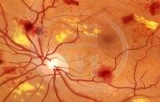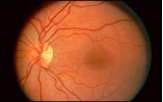Diabetic Retinopathy (Diabetic eye disease)
What is diabetic retinopathy?
Diabetic retinopathy is the main cause of blindness in people younger than 60 years of age. It affects the vessels at the background of the eye (retina), which leak fluid and also bleed. If the macula is compromised (the central sensitive area of the eye), there is drop of vision. Few diabetics also develop abnormal vessels inside the eye (new vessels), which are fragile and can bleed, causing sudden drop of vision. Finally, occassionally normal vessels can be so affected, that blood circulation inside the eye is disrupted and due to cell death, drop of vision is irreversible.
All diabetics are at risk of developing diabetic retinopathy and the risk is increased proportionally to the duration of the disease. Eventually all diabetics will develop some degree of diabetic retinopathy. That is the case for both diabetics type 1 and type 2. It is very important to understand that severe diabetic retinopathy can affect even people with optimal diabetic control (simply because of the duration of diabetes), although the chances are much higher in those with poor diabetic control.
In early stages there are unfortunately no visual symptoms, even in patients with severe damage at the background of the eye. When the bleeding and the leakage extend to the central area, there is drop of vision. In cases of bleeding from abnormal vessels, vision can drop suddenly, since the eye fills with blood. Diabetic retinopathy does not cause pain.
Depending on the case, there are two forms of treatment:
- Intravitreal injections are used today for visual improvement in diabetic retinopathy that affects the central part of the eye (diabetic macular edema).
- Laser treatment can stop or even improve disease symptoms. Laser seals the leaking and bleeding vessels. In cases of abnormal vessel formation, laser treatment extends in a large area of the background of the eye (but not in the area of central vision) and that usually causes the abnormal vessels to regress and stop bleeding inside the eye.
It is mandatory that all diabetics must check the background of the eye (fundoscopy) at least once a year, irrespective of the type of diabetes, duration of the disease and diabetic control (even if it is optimal). This examination shows the presence and the severity of diabetic eye disease and the need for treatment. It is very important to prevent serious damage at the background of the eye before significant and irreversible loss of vision happens. That can only be done with proper diagnosis and treatment.
Dr George Kampougeris has acquired extensive experience in follow up and treatment of diabetic retinopathy during his subspecialty training in the United Kingdom. He has performed over 10.000 lasers and injections in diabetic eyes.




- Private Practice Office
- CHALANDRI INSTITUTE OF OPHTHALMOLOGY Katsoulieri 4 st., 1st floor at 'FLIA' Mall Chalandri, Athens, Greece
- 210 77 11 168, 210 68 56 686
- 6944 89 66 33
- gkampougeris@yahoo.gr
© 2024 Eyedoctorgk. All Rights Reserved – Powered by Focus on Web

